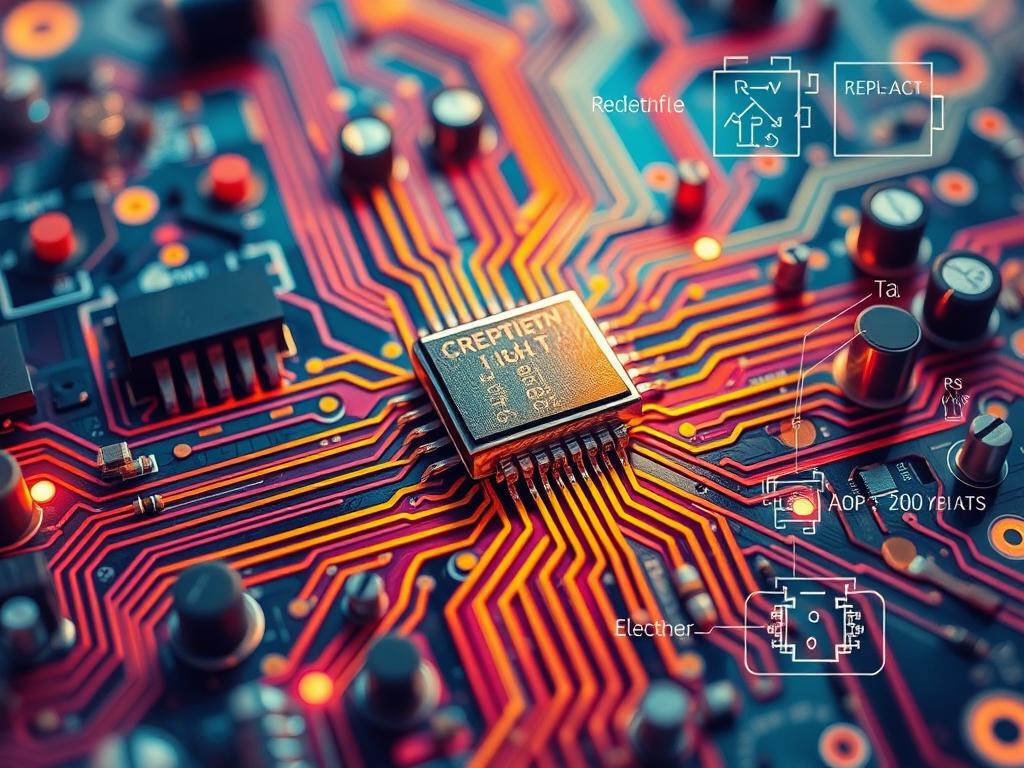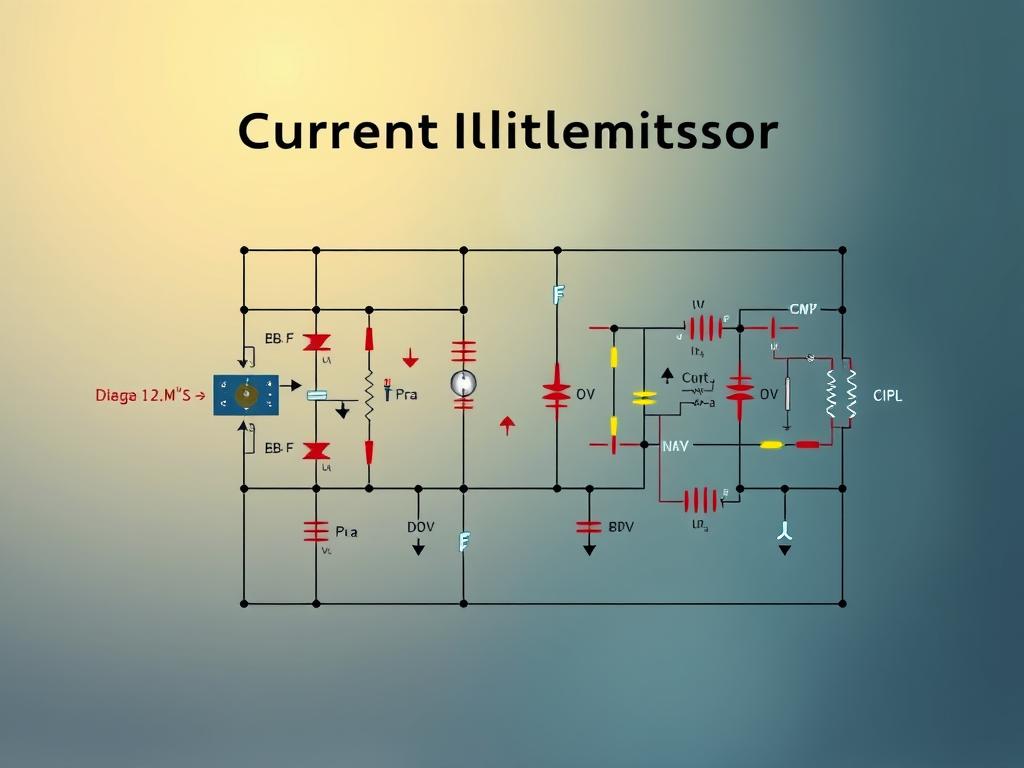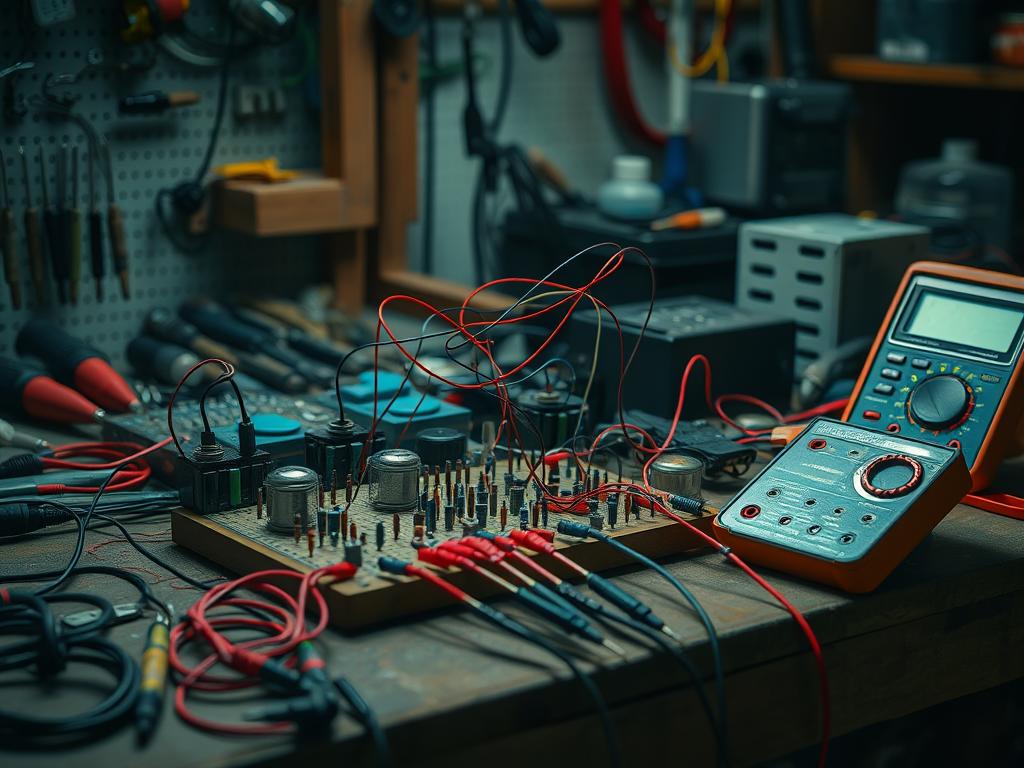In the world of electronic circuit design, keeping sensitive parts safe from too much current is key. Current limiting circuits are vital for keeping devices working well for a long time. Transistors are a top choice for this job because they can control current flow accurately.
Transistors, like BJTs and MOSFETs, are used a lot for current limiting. They work like electronic switches, changing current levels as needed. This lets designers create current limiting solutions that fit their specific needs.
Key Takeaways
- Current limiting circuits are essential for protecting electronic components from damage due to excessive current flow.
- Transistors, including BJTs and MOSFETs, are widely used as current limiting devices, offering precise control and adaptability.
- Proper selection and implementation of transistors in current limiting circuits can enhance circuit longevity and prevent overheating.
- Understanding the characteristics and applications of different transistor types is crucial for designing effective current limiting solutions.
- Integrating current limiting features into electronic designs can significantly improve the overall safety and reliability of the circuit.
Understanding Current Limiting: An Overview
Current limiting is a key method in electronic circuits. It limits the electric current to a set maximum. This is crucial for protecting parts, avoiding overheating, and keeping circuits safe and reliable.
What is Current Limiting?
Current limiting is about controlling the current in a circuit. It checks the current and lowers the voltage if needed. This keeps the current safe. Special circuits do this by watching the current and adjusting the voltage.
Importance of Current Limiting in Circuits
- Extends the lifespan of electronic components by preventing overcurrent conditions
- Enhances circuit safety by mitigating the risks of electrical hazards and fire
- Maintains circuit efficiency by regulating the current flow and preventing excessive power dissipation
- Enables the use of smaller, more cost-effective components by limiting the maximum current they need to handle
Current limiting is vital in electronic circuits. It acts as a key safety measure. It prevents overcurrent, ensuring circuits are safe and current is well-regulated.
“Current limiting is essential for protecting sensitive components, preventing overheating, and ensuring circuit safety.”
| Limiting Technique | Description | Advantages | Disadvantages |
|---|---|---|---|
| Constant Current Limiting | Maintains the output voltage as the current rises until a maximum point is reached and then maintains the current at that level while the voltage decreases with increasing load. | Simpler circuit design, fewer components | Does not reduce current in case of a short circuit |
| Fold-back Current Limiting | Maintains the output voltage until current limiting activates, at which point the current starts to decrease, reducing the risk of damage. | Better protection against overload, reduced power consumption | Slightly more complex circuit design |
Understanding current limiting helps electronics experts create safer circuits. They can protect against overcurrent and ensure their systems last longer.
The Role of Transistors in Current Limiting
Transistors are key in current limiting circuits. They act as amplifiers or switches to control electricity flow. This ensures the current stays within a set limit. This method is vital for controlled power dissipation in many electronic circuits.
Types of Transistors Used
There are various transistors for current limiting, like BJTs and FETs. The right transistor depends on the application’s needs. Transistors like the TIP120 or MOSFET are often chosen for their high current handling and quick switching.
How Transistors Regulate Current
Transistors control current by managing the voltage across the load. When current gets too high, the transistor kicks in. It reduces the voltage and current, protecting the circuit from damage.
| Resistor Value for Current Limit | Power Rating for Resistor |
|---|---|
| 1.5 ohms for 0.5 amps | 0.375 watts |
| 0.33 ohms for 2 amps | 1.32 watts |
Other parts like thermistors, current limiting diodes (CLDs), and circuit breakers also limit current. The right choice depends on the application’s needs and desired control level.

“Transistors, diodes, and integrated circuits are highlighted as parts of regulated power supply units that incorporate active current limiting circuits, indicating a common use of transistors in managing and controlling current flow in circuits.”
Applications of Current Limiting in Electronics
Current limiting circuits are key in keeping electronic parts safe. They prevent damage from too much current. This damage can cause parts to overheat or even fail.
Let’s look at how current limiting helps in electronics.
Protecting Sensitive Components
Parts like microprocessors and memory chips can get damaged by too much current. Current limiting circuits protect these parts. They keep the current in check, preventing damage and extending the life of important devices.
Power Supply Circuits
In power supply circuits, current limiting is vital. It keeps the power supply and the connected load safe. This is especially true when the load’s needs change suddenly, like in battery chargers or LED drivers.
Using current limiting in power supplies keeps them running smoothly. It prevents overheating and fires. This way, power supplies can handle unexpected changes or faults without failing.
“Current limiting is a critical safety feature that protects electronic components and ensures the overall reliability of electronic systems.”
In short, current limiting is used in many ways in electronics. It keeps parts safe and power supplies working right. By using circuit protection techniques, designers make electronics safer and more reliable. This leads to better electronic solutions.
Key Benefits of Implementing Current Limiting
Using current limiting in electronic circuits has many benefits. It makes your designs more reliable and safe. One big plus is enhanced circuit longevity. It protects sensitive parts from damage caused by too much current.
This means your circuits can work longer without breaking down.
Prevention of Overheating
Current limiting also helps prevent overheating in components. It controls how much power is used, which lowers the chance of parts failing due to heat. This keeps your designs safe from overheating damage.
Overheating can hurt your system’s performance and shorten its life.
Also, circuit protection techniques with current limiting make your circuits safer. They reduce the risk of electrical and fire hazards. This makes your safe circuit design more reliable.
Moreover, current limiting can make your circuits more efficient. It helps use power better and cuts down on waste. This boosts your design’s performance and saves money and the environment.
“Implementing current limiting is a crucial step in ensuring the long-term reliability and safety of your electronic circuits.”

By using current limiting, you can protect your electronic parts and make your designs last longer. It also helps your circuits work better and use less energy. Adding these techniques to your safe circuit design is key to making your electronic systems strong and dependable.
Designing Circuits with Current Limiting Features
When designing circuits with current limiting features, there are several best practices to follow. These ensure safe and reliable performance. Key considerations include the type of load, current and voltage ratings, response time, efficiency, temperature range, and overall cost.
It’s crucial to ensure the current limiting circuit can handle the maximum possible voltage in the system. This might mean choosing components with higher voltage ratings or adding extra protection. Also, components must operate reliably within the specified temperature range for consistent current regulation.
Best Practices for Circuit Design
- Account for the load type and its impact on current requirements
- Properly size components to handle the maximum voltage and current levels
- Optimize the current limiting circuit’s response time for the application
- Consider efficiency and heat dissipation when selecting components
- Ensure the circuit can operate within the specified temperature range
- Balance cost and performance when choosing components
Common Mistakes to Avoid
One common mistake is underestimating the importance of response time in the current limiting circuit. Slow response times can lead to damage or instability in the system. Another mistake is neglecting efficiency considerations, which can result in excessive heat dissipation and potential component failures.
Additionally, failing to account for variations in transistor parameters across different devices of the same type can compromise the consistency and accuracy of the current regulation. Careful component selection and testing are crucial to mitigate these issues.
“The key to designing safe and reliable circuits with current limiting features is to consider all the relevant factors, from load characteristics to component performance and efficiency.”
By following best practices and avoiding common pitfalls, engineers can create safe circuit design with effective current regulation with transistors. This ensures the long-term stability and protection of their electronic systems.
Real-World Examples of Current Limiting
Current limiting is key in many electronic devices. It keeps components safe by stopping too much current. This prevents overheating, damage, and fire risks.
Consumer Electronics
In gadgets like smartphones and laptops, current limiting is common. For example, Arduino boards have limits to protect their parts. High-energy batteries also need careful current control to avoid fires.
Industrial Applications
In big machines and systems, current limiting is vital. It keeps expensive parts safe and ensures safety. Testing devices’ current use is important to avoid problems.
It’s crucial to know each device’s current needs. This helps ensure they work right. Devices like regulators have specific current limits.
| Application | Current Limiting Requirement |
|---|---|
| Smartphone Chargers | Protect sensitive electronics and prevent overheating |
| Laptop Power Adapters | Ensure safety and maintain reliability of power supply |
| LED Lighting Systems | Regulate current to prevent LED damage and ensure consistent brightness |
| Motor Drives | Safeguard expensive equipment and ensure operational safety |
| Power Distribution Systems | Prevent equipment damage and maintain stable power delivery |
| Industrial Automation | Protect sensitive components and ensure reliable operation |
These examples show how transistor applications and electronic component safety are used everywhere. They highlight the importance of current limiting in today’s electronics.

Selecting the Right Transistor for Current Limiting
Choosing the right transistor is key to protecting your circuits. It’s about picking the right one for current limiting. You need to think about a few important things to get the best results.
Factors to Consider
The first thing to look at is the transistor current limiting capacity. This means checking the maximum collector current and the peak pulse collector current. It’s also important to set the actual collector current at 50% of the maximum for a reliable design.
Also, make sure the collector-emitter voltage, emitter-base voltage, and collector-base voltage are within the limits. This helps avoid damaging the transistor right away.
Power dissipation is another big factor. Transistors have limits on how much power they can handle. It’s best to operate at 50% of these limits to make the transistor last longer. You need to do thermal resistance calculations to figure out the maximum power rating at different temperatures. This ensures the transistor stays safe.
Popular Transistor Models
For low-power needs, the 2N3904 (NPN) and 2N3906 (PNP) transistors are good choices for transistor current limiting. For more power, the TIP31 (NPN) and TIP32 (PNP) are better. For high-power and high-frequency needs, MOSFETs like the IRF540N are the best option to protect your circuits with transistors.
When picking a transistor, think about what your circuit needs. Consider the current handling, voltage, switching speed, and power dissipation. By looking at these factors, you can find the best transistor for your circuit design.
“Selecting the right transistor for current limiting is essential to prevent thermal runaway and ensure the long-term reliability of your circuits.”
Testing and Troubleshooting Current Limiting Circuits
Testing and fixing current limiting circuits is key to their correct working and safety. It’s about using the right tools and methods to check how well the circuit works and find any problems.
Tools and Techniques
For checking current limiting circuits, you need multimeters, oscilloscopes, and current probes. Multimeters help measure voltage drops. Oscilloscopes show waveforms to check if the circuit limits current right. Current probes measure current directly in the circuit.
Testing these circuits mainly means checking voltage drops and looking at oscilloscope waveforms. This helps see if the circuit limits current as it should. It also spots any odd behavior or issues.
Common Issues and Solutions
Common problems with current limiting circuits include wrong component choices, bad biasing, and thermal runaway. These can cause poor current limiting, too much heat, and damage to the circuit.
To fix these, you might need to change component values, improve cooling, or redesign the circuit. This could mean using stronger transistors or ICs, or adding cooling systems to stop overheating.
| Current Limiting Technique | Circuit Complexity | Power Dissipation | Applicability |
|---|---|---|---|
| Constant Current Limiting | Simpler | Higher | Suitable for linear power supplies |
| Foldback Current Limiting | Slightly More Complex | Lower | Preferred for non-linear loads |
By using the right tools, methods, and fixes, engineers and technicians can make sure current limiting circuits work well. This improves circuit protection and prevents overcurrent in many electronic devices.

Integrating Current Limiting into Existing Designs
Adding current limiting to existing circuits can be tricky. It often means changing parts and the layout. This can be hard because of space, power, and keeping the circuit working well.
Retrofits and Modifications
Adding current limiting needs careful planning. Engineers must pick the right method and make sure it fits with the circuit. This might mean adding new parts while keeping the design looking good.
Challenges and Considerations
One big challenge is balancing protection with power and performance. Designers must choose parts that handle current and voltage well. They also need to make sure the circuit fits the new parts, especially in tight spaces.
Changing the circuit can affect how it works. It’s important to test and validate the changes. This ensures the circuit still works as it should.
Engineers need to use their safe circuit design skills. By thinking carefully and using best practices, they can make the circuit safer and more reliable. They can do this without changing its main function.
Future Trends in Current Limiting Technology
The electronics world is always changing. New transistor designs and uses are leading the way in current limiting tech. These changes aim to make devices more efficient, smaller, and dependable for today’s tech needs.
Innovations in Transistor Design
New materials and ways to make transistors are big trends. 3D thin-body CMOS structures and gate-all-around transistors are improving. They can handle more current and lose less power.
Since 2007, 3D NAND flash memory layers have grown from 4 to over 200. This shows how fast transistor design is advancing. New materials like 2D semiconductors are also being looked at for their potential in transistors. These could lead to even smaller, more efficient transistors that are safer for electronics.
Emerging Applications
- High-frequency power converters: New transistor designs are making power converters more efficient and smaller. They’re key for renewable energy and electric vehicle charging.
- Electric vehicle charging systems: Transistor current limiting is vital for safe and reliable EV charging. It prevents overcurrent and overheating.
- Renewable energy systems: As we need more green energy, current limiting tech is key. It’s used in systems for solar and wind power.
New uses and transistor tech are pushing for better current limiting solutions. These solutions are more efficient, compact, and reliable for the electronics world.
Comparing Current Limiting Methods
Engineers use two main ways to protect electronic circuits: resistor-based and active current limiting. Knowing the differences between these is key for good [circuit protection techniques] and [current regulation with transistors]. This is important in many applications.
Resistor-Based Limiting
Resistor-based current limiting is simple and cheap. It works by adding a resistor in series with the load. This limits the current based on the resistor’s value. It’s common in power supplies and LED drivers.
But, it’s not very efficient. The resistor wastes power and gets hot. This can lower the system’s performance.
Active Current Limiting
Active current limiting uses transistors or ICs to control current. It’s more precise and efficient than resistor-based methods. It can adjust to changing loads and protect sensitive parts better.
Choosing between these methods depends on several factors. These include precision needs, efficiency, cost, and application specifics. For simple, cheap designs, resistor-based might work. But for critical applications, active current limiting is better.

Effective current limiting is crucial for protecting electronic circuits. It ensures they work reliably. By understanding [circuit protection techniques] and [current regulation with transistors], engineers can pick the best solution for their projects.
Troubleshooting Common Issues in Transistor Circuits
Regulatory Standards and Current Limiting
In electronic circuit design, current limiting is key for safety. It follows strict regulatory standards. These rules ensure electronic component safety and safe circuit design for reliable electronics.
Navigating Relevant Industry Standards
Many industry standards focus on current limiting in circuits. The IEC 60950 standard for IT equipment and the UL 1310 standard for Class 2 power units require current limiting. They protect against overloads and short circuits. The IEC 61000-4-5 standard for surge immunity also ensures circuits can handle voltage spikes safely.
Compliance and Best Practices
Following these standards is crucial for responsible circuit design. Best practices include designing for fail-safe operation and using redundant protection. Thorough testing under different conditions is also key. This ensures current limiting works well.
Effective current limiting is vital for electronic component safety and system reliability. By knowing the standards and using best practices, engineers can make strong, safe circuits. These circuits meet modern electronics needs while keeping users safe.
Conclusion: Embracing Current Limiting for Circuit Safety
Current limiting is key in circuit design. It boosts safety, reliability, and extends component life. By choosing the right transistors and understanding current limiting methods, experts can create strong protection plans for their circuits.
Summary of Key Takeaways
This deep dive into current limiting shows its importance. It’s about picking the right transistor and knowing the pros and cons of current control. Following industry standards is also crucial. Learning about current limiting is vital for keeping electronic systems safe and working well.
Final Thoughts on Protection Strategies
The electronics world is always changing. Using good current limiting strategies is more important than ever. Keeping up with new tech, adding current limiting to designs, and following safety rules are key. Knowing how to use current limiting is a big plus for anyone making electronics.


